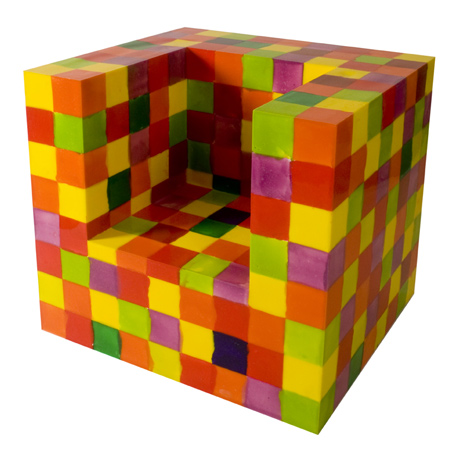
Alessandro Ciffo at Dilmos
Milan 08: artist Alessandro Ciffo presented multi-coloured silicone furniture at Dilmos gallery in Milan last month.

The collection includes an armchair, chest, cupboard, sideboard and small table.

Photographs by Emilio Tremolada.
Here is some text from Dilmos, followed by an interview with Ciffo by Clara Mantica:
--
Multicolored Silicone Furnishings by ALESSANDRO CIFFO (EDIZIONI DILMOS)
"Paso Doble: Ciffo and Silicone"
With each forward step, the past is brought to a synthesis with ingenious surprise. Unforced, it is the offspring of a natural evolution born of a fluid dialogue between creativity and materials.
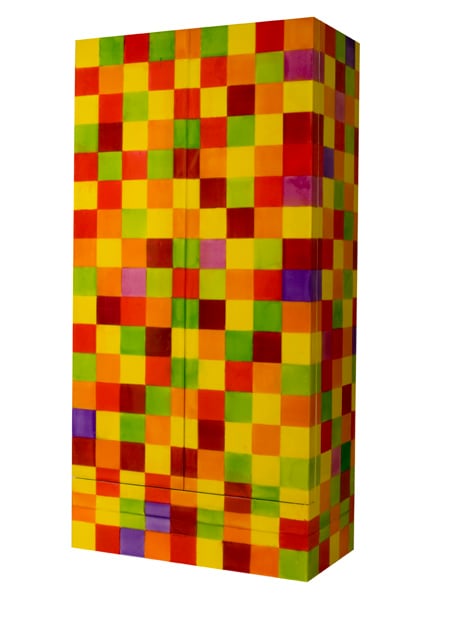
Ciffo always delivers with facts and if this is where he has brought us today, soon he will surely takes beyond.
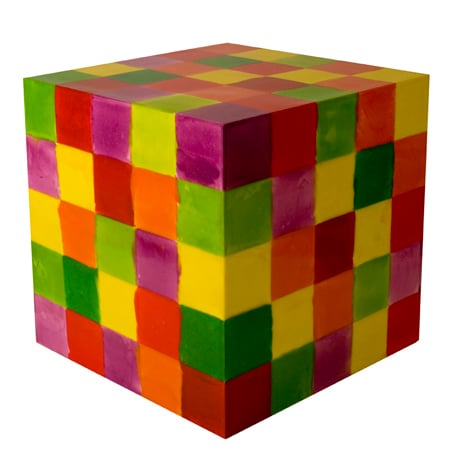
Of his checkmate, the designer says: "I blend design with painting, painting with volumes, the inflexibility of corners with the softness of the material and of gestures. It is the natural progression down the path I took last year with the 'solidi molli' where silicone defies and then designs volumes, ultimately satisfying the need for function: an armchair, a cupboard, a chest, a table or a desk. As it both challenges and softens those overly rigid theories that hinder the processes of evolution, silicone, in the end, puts all under check mate".
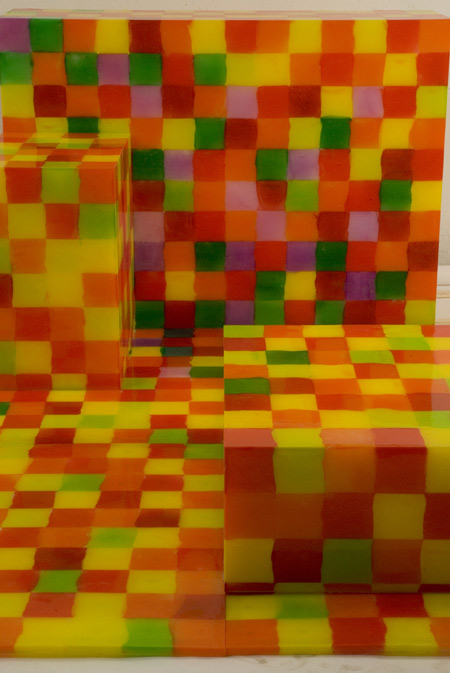
On the occasion of the exhibition DILMOS has prepared "SCACCOMATTO", a catalogue published by Emptybox with texts by Clara Mantica and images by Emilio Tremolada.
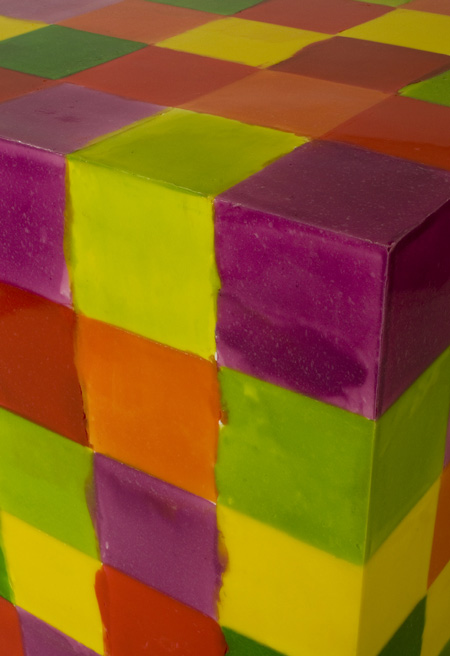
THE POWER OF WORK - Interview by CLARA MANTICA
We were first introduced by Lella Valtorta, the ever sensitive and highly cultured godmother of all movements between art and design. She approached me in 2003 or 2004, saying “there is a young author who wants to prepare a catalogue.”
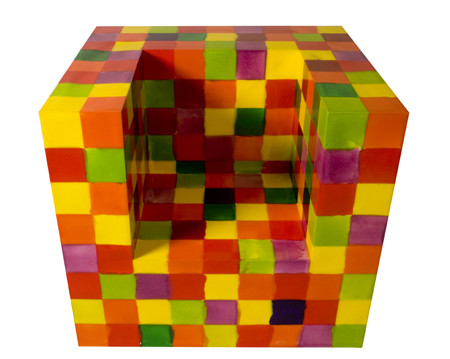
More than editing the book, my job consisted in guiding Alessandro towards a coherent reading of himself and of his own work.
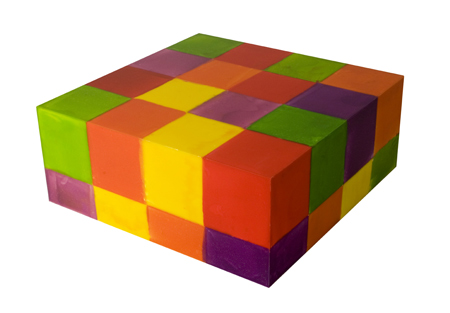
When I first met Ciffo he was burdened with neither the prejudices nor the culture which derive from the world of art and design. The fact that he is self-taught has represented a key factor in his development. At first he did not even know who Gaetano Pesce was and was baffled and amused when it was suggested that he had imitated Pesce's work. He was lacking in theory yet was endowed with an acumen and courage in his practice which were out of the ordinary.
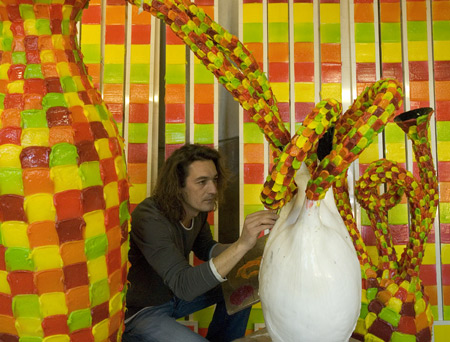
We exchanged opportunities to investigate and explore some of the most central aspects of both our lives. In Ciffo’s own words: “You were my best guide. The first book we published together was vital in sharpening my vision of the road I wanted to follow.” From my own point of view, Ciffo helped me to enter into his experiences, enabling me consequently to make it my own. Thus, as he showed me his workshop, tools and past, present and future creations, introducing me to his friends (who, like the in-house design manufacturers they are, are true individualists and each walk on their own two feet). I was thus able to enter into the spirit of in-house design manufacture, drawing up a “manifesto” on the topic in which Ciffo (and his friends) were able, to my considerable satisfaction, to see their own aims and ideals reflected
Our relationship is therefore highly reciprocal, despite our difference in ages and roles, with me wielding the pen and he the spatula.
And we still meet up, despite both of our many commitments, on occasions such as now, in March 2008. when we met to discuss this new book and his most recent works. And on this occasion, too, I found that I had something new to learn.
What’s been happening to you since 2005? What new recognitions have you received?
After that memorable April I was invited to represent the Italian design world in Athens at the “Art of Italian Design” exhibition curated by Alessandro and Francesco Mendini and in 2006 I exhibited in Turin for the Cultural Olympics at the “Torino Piemonte Design” exhibition curated by Claudio Germak e Claudia De Giorni. Next, I was involved in Tonucci-Design’s “Materie” exhibition and the triennial “The new italian design il paesaggio mobile del nuovo design italiano” organised By Andrea Branzi in Milan. In 2007 I held my first individual retrospective in Turin at the Tipostampa gallery run by my friend, the collector Marco Parini, a large, round space where I felt amply able to express myself. Andd now, after the Marmimolli (soft marbles) exhibition in Rome, I’m going to hold a personal exhibition entitled “Scaccomatto” at Dilmos, which I always consider to be one of my key points of reference.
How has your work evolved?
I took on my latest challenge in 2007, with my “soft solids” project which gradually evolved into a range of furniture with all the difficulties which that involved: doors, hinges and colour and design coordination, lights and thicknesses which needed to be precise to the millimetre, all the time working in a material which does not easily lend itself to such precision. Now I’m 99% satisfied with the results. There’s still a bit of room for improvement, but I’d say they’re more or less ok.
And how about your tools and techniques?
Everything is evolving. I am constantly reining my tools, even if they are still pretty primitive. As far as my techniques go, I would go so far as to say that by now they’re pretty well established and my time management is almost impeccable. I’ve started working in riverse, starting from the external surface and moving inwards towards the heart of the object. That is how my napkins, surface tops and furniture have all come into being. The colours are more nuances, more light and use resistant.
And the next step ?
A new soft Cinquecento for Fiat, who have asked me to cover that model in silicon. Who knows if it will turn out to be the beginning of a beautiful friendship between silicone and the automobile industry … from industry to art and back again. I’ve also got a collaboration with Eva and Roberto Cavalli lined up. They are intereste in my work and are giving me an opportunity to introduce silicone into the world of fashion. Finally, I’ve got a personal retrospective lined up before the end of this year at the Napoli Plart.
Do you still see yourself as a craftsman?
I imagine that when you have a big workload you must need to share it out. Two young friends who want to learn the trade have been helping me for about a year … which means that I am teaching them. Having to teach something is always a great test: it makes me pause over things I would otherwise take for granted. I improve and order them, honing down my language when I speak about them. Sharing knowledge is a good thing. It is important to open up to others who can add new knowledge to what you have found out, new experiences to your experience. I would hope that the bureaucracy surrounding this kind of work for young people and their apprenticeships will be simplified over the years to come. I hope to lend them my support in that particular battle.
The power of work was the title of one chapter in our first book and is now the heading to this section. Do you consider that such a title could pave the way to an understanding of your work?
Art is often divided up according to work-related questions: “who does the work? Is it the artist or does he or she have it done?” The niche in which I myself work, between art and design, is attracting an increasing amount of interest from galleries, collectors and the public, precisely because it unites the work to the idea. Design has the role of re-evaluating and this re-evaluation is carried out through both the form and the art. Work as a concept comes to be re-evaluated and celebrated.